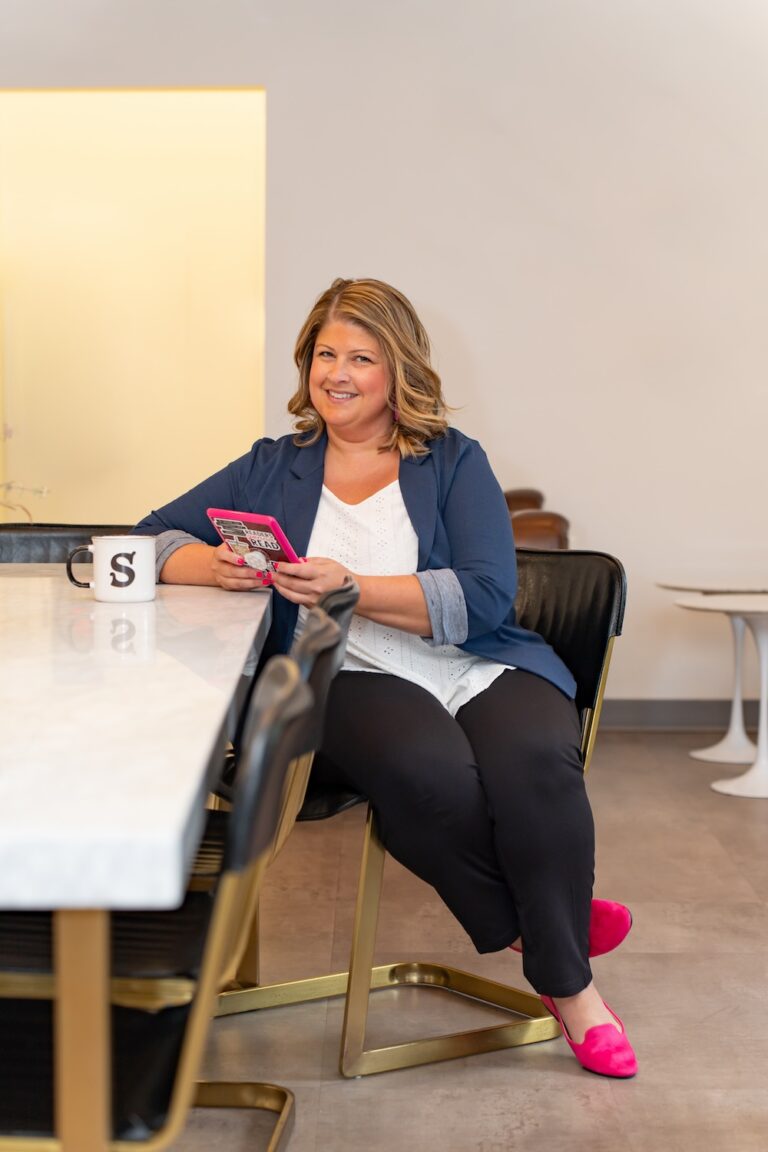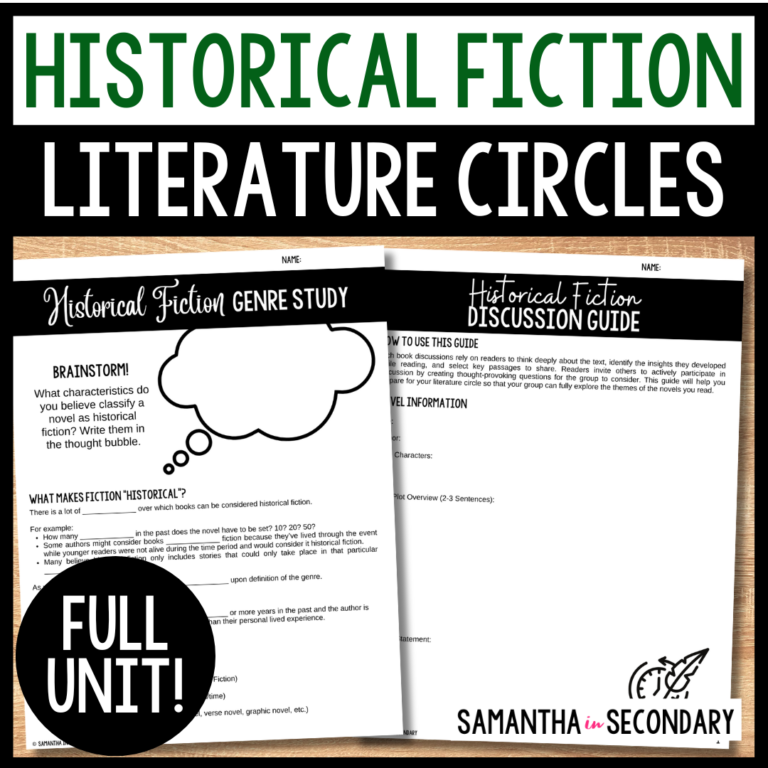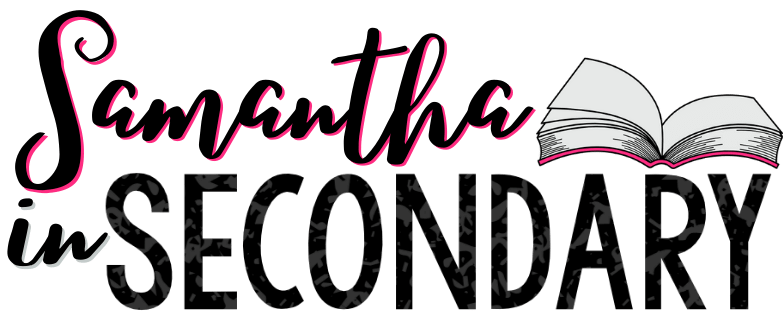Over the next few episodes, we’re going to talk about a new genre that I’ve personally witnessed help to shape lifelong readers. I know that sharing this genre in your classroom is going to hook an entirely new set of students. Settle in, joyful reader, because today I’m going to encourage you to introduce your students to historical fiction.
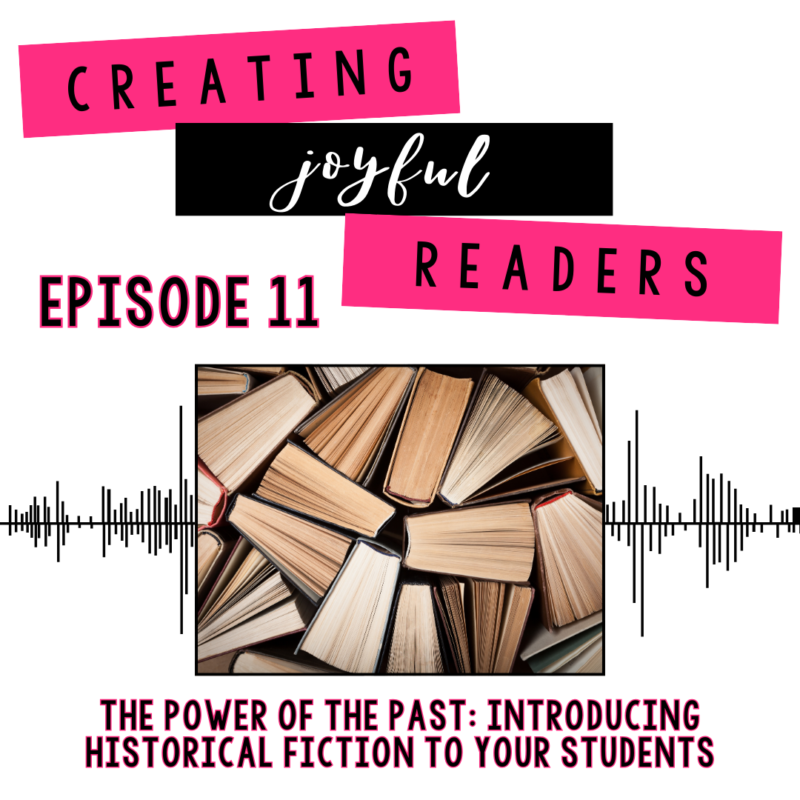
Links & Resources:
Take a closer look at my Historical Fiction Unit HERE
Some links referenced here are affiliate links. Supporting the podcast through these links comes at no additional cost to you.
–> Shop for your modern day literacy classroom HERE:
https://www.teacherspayteachers.com/store/samantha-in-secondary
–> For tips, book recommendations, and connection with other educators follow along on INSTAGRAM:
https://www.instagram.com/samanthainsecondary/
–> Shop my favorite YA books HERE:
Prefer to read? Open the transcript here.
Samantha 00:00
Hi there and welcome back to creating joyful readers. I’m your host, Samantha. I can’t believe it’s been over a month since we launched the podcast. I am so incredibly grateful for the warm welcome and support you’ve all shown this passion project of mine. I hope the episodes so far have inspired you to try something new as you continue to do the important work of encouraging kids to love reading. My goal is to continue to support you with fresh ideas and inspiration to create a strong culture of reading in your educational space. Over the next few episodes, we’re going to talk about a new genre that I personally witnessed helped to shape lifelong readers. I know that sharing this genre in your classroom is going to hook an entirely new set of students. Settle in joyful reader, because today I’m going to encourage you to introduce your students to historical fiction.
Samantha 00:47
Welcome to Creating Joyful Readers – A podcast dedicated to empowering secondary educators with the tools, strategies, and inspiration to cultivate a lifelong love of reading in their students. I’m your host, Samantha. Tune in each week as we explore the transformative power of independent reading. Delve into the latest research on literacy, dissect projects that will help your students showcase what they’ve learned in a unique way, and share curated recommendations of young adult novels that will captivate and engage your learners. Join in as we embark on a journey to create joyful lifelong readers one book at a time.
Samantha 01:24
Last month, we dove into mystery. In my experience, mystery is a much easier sell than most genres. Students have a lot of exposure to mystery and are more familiar with it than some other genres. Mystery is exciting, and there is a sense of anticipation as students discover books that entertain and delight them. On the other hand, historical fiction is a genre that a lot of students probably see as something they have to read in school. Besides your students who are naturally attracted to history, other readers might not realize that historical fiction has a lot to offer. When I’m introducing this genre to students, I love to read a few quotes that might inspire them to open their minds to the experience. Here are two. History tells us what people do. Historical Fiction helps us imagine how they felt. Guy Vanderhaeghe. Historical fiction is not only a respectable literary form, it is a standing reminder of the fact that history is about human beings. Helen Cam. There are plenty of reasons your students will love historical fiction, but here are just a few. Students who love action and adventure will love historical fiction because history is filled with movement. Often there are romantic subplots woven into the fabric of the genre. So your romance readers will be intrigued. Teen readers of historical fiction could often visit places and cultures they might not have otherwise been able to experience. There are so many reasons to consider running a historical fiction unit in your classroom. Let’s start with a little background. Historical fiction was never originally called historical fiction by those writing it. The genre itself was founded 1000s of years ago, and examples of it can be found across every culture. Ancient epic poems like Homer’s The Iliad, medieval tales such as Geoffrey Chaucer’s the Knight’s Tale, and Renaissance plays like Shakespeare’s Richard the second are just a few early examples of historical fiction and Western literature. Fast forward to 1867 and Leo Tolstoy’s War and Peace is widely regarded as one of the first novels to officially be recognized in the genre. Since then, historical fiction has grown immensely, with 1000s of works published over the years. Today, publishing giants in the industry such as Kristin, Hannah, Barbara, Kingsolver, and Kate Quinn are continuously landing at the top of bestselling booklists. There has also been a boom of historical fiction shows becoming increasingly popular. Diana Gabaldon’s Outlander is the basis for an ongoing TV series from Starz, Bridgerton, originally written by Julia Quinn, is also an extremely popular series on Netflix, championed by the talented Shonda Rhimes. It’s also worth noting that the incredibly popular musical Hamilton is based on the historical fiction novel Alexander Hamilton by Ron Chernow. This musical has had sweeping popularity with fans of all ages, but has also succeeded in bringing many younger viewers to the genre. Some people refer to this as the Hamilton effect. So why? Why are people so enthralled with historical fiction? Many people think it’s because stepping back into history makes us nostalgic for a time we believe was more peaceful than the world is today. Read 50 pages into any historical fiction novel, and you’ll quickly realize that isn’t at all true, but perhaps it’s the hope that maybe it was another theory takes into account the pace in which we live our lives today. Perhaps people are yearning for a time where they weren’t constantly distracted by the incessant pinging of a phone. Maybe they’re not looking for peace. They’re looking for quiet.
Samantha 04:49
There’s a lot of debate about what actually makes fiction historical. The writer may be writing it from their own perspective, which would make it contemporary, but since younger readers did not live through that time they may consider it historical for our purposes. As we work through this genre, we’re going to be using a common definition so that we’re on the same page. This is an important distinction to make when you’re working with students as well. Here’s our definition. Historical fiction is any text which is set 50 or more years in the past, and the author is writing from research rather than their personal lived experience. There are also many subgenres of historical fiction, such as fictional biographies, historical mysteries, historical romance, alternate history, also called speculative fiction, war novels, and time travel novels. Historical fiction is also known to be very popular with crossover novels, such as a novel rooted in both historical and fantasy elements.
Samantha 05:46
Historical fiction is all about blending real and fictional events, creating a seamless narrative that feels both authentic and engaging. The characters face problems that are true to the time period, whether they’re real historical figures or imagined individuals who could have lived during that era. The setting itself must be mostly historically accurate, immersing the reader in a world that feels plausible. What makes this genre so powerful is its ability to emphasize themes that resonate with both the past and present, helping readers connect with history in a meaningful way. For all that historical fiction does well, there are also plenty of criticisms of the genre. Historical fiction often faces criticism, with many believing it’s a genre that’s not always executed well. Some common critiques include authors not doing enough research, leading to stories that feel inauthentic or full of historical mistakes. Sometimes the plot feels non existent, or the book reads more like a fictionalized textbook, weighed down by too many facts. Others say the writing can feel robotic, or it’s bogged down by old fashioned language like thee and now characters can also feel out of place, earning the nickname costume characters, and there’s concern that authors take too many liberties with the history, turning the story into speculative fiction instead. Here are five different types of students who might love historical fiction. First, we have the history buff, students fascinated by the past, who enjoy learning about historical events, figures and cultures. They will appreciate how historical fiction brings history to life. Next, we have adventure seekers, teens who enjoy action, drama, and high stakes conflict will love the adventurous and often dangerous settings of historical fiction, from wars to revolutions. Third is our empathetic readers. Students who connect deeply with the characters emotions and struggles will be drawn to the human stories behind major historical events. Fourth is the critical thinkers, those who enjoy analyzing the mix of fact and fiction, questioning historical accuracy and exploring how the past impacts the present, will thrive studying this genre. And last but certainly not least, are our fantasy enthusiasts. Readers who enjoy immersive world building and fantasy may enjoy historical fiction’s richly detailed settings, especially in ancient, medieval or Renaissance periods, where the past can feel almost like a different world.
Samantha 08:07
Today’s episode explored the world of historical fiction from its fascinating origins to why it can captivate a diverse array of students. We discussed what makes fiction truly historical, the various sub genres it offers and some common critiques the genre faces. Finally, we identified five types of students who would love historical fiction, including history buffs, adventure seekers and critical thinkers.
Samantha 08:31
If you’re ready to dive in and teach historical fiction for the first time, or you’re looking for some material to refresh a practice, you can use my tried and true unit, head to teachers pay teachers and search for my shop, Samantha in Secondary to find print and go solutions that will make it easy to share historical fiction with your students in a meaningful way. I filled my unit with everything you need to introduce your students to the genre, whether you’re planning a full class unit or complementary literature circle, including a full unit plan that’s easy to follow. Head to my shop and search for historical fiction, or just check the show notes for the link. I hope this episode inspired you to consider introducing historical fiction in your classroom. Stay tuned for more tips and ideas to keep sparking a love of reading in your students together, I feel confident we can find a joyful title for every learner in your classroom. Thanks for listening, joyful reader, and I’ll meet you in the next episode.
Samantha 09:23
Thanks for tuning in to creating joyful readers. I hope you found inspiration and practical strategies to ignite a passion for reading in your students. Remember, every book we introduce and every reading experience we foster can transform lives and help students become lifelong readers. Follow me on social media at samantha in secondary for more tips book recommendations and to connect with a community of educators dedicated to making reading a joyful journey. Until next time happy reading.
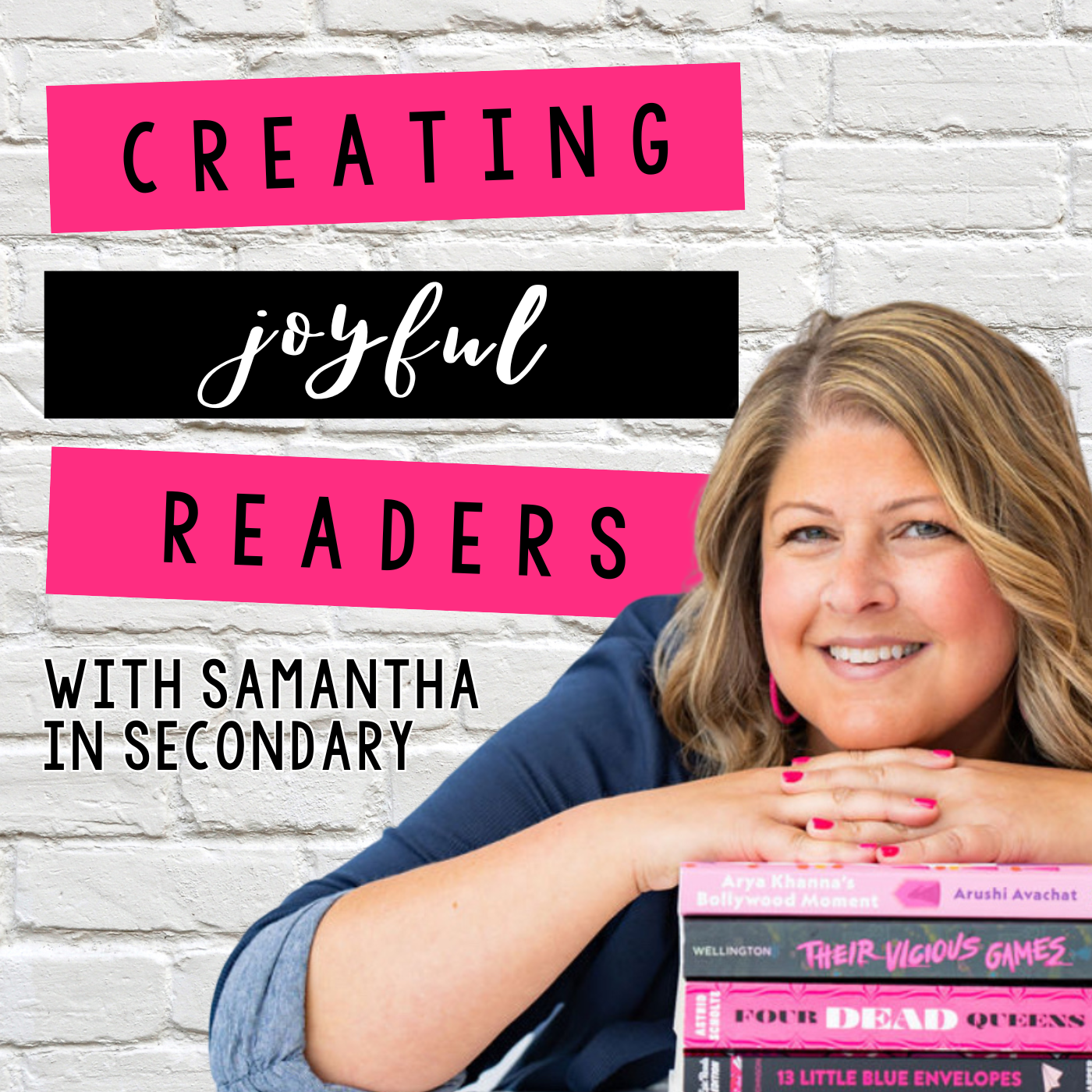
The Podcast
Creating Joyful Readers
It is possible to inspire a lifelong love of reading in secondary ELA students and that’s what the Creating Joyful Readers podcast is all about.
Join us every Monday as we dive into the latest in literacy research, talk about fresh Young Adult book recommendations, and chat fresh strategies to motivate your secondary students to love reading again.
Meet Your Host
Welcome! I’m Samantha, a veteran educator with 15 years of classroom experience and a Masters in Education, dedicated to transforming how students experience reading. My passion lies in empowering ELA teachers to foster joyful, independent readers in their classrooms.
Through this podcast, I’ll share the latest literacy research, practical tips, creative project ideas, and fresh book recommendations, all designed to help you ignite a love for reading in your students and make reading a delightful adventure, not a chore.
